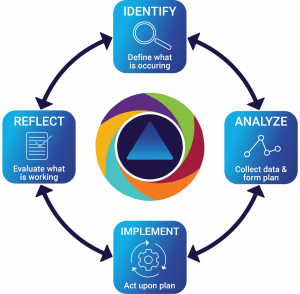NeMTSS Framework | Nebraska Department of Education
The NeMTSS Framework is designed to provide an overview for MTSS practices in Nebraska. As such, it will chart the course for school-wide implementation from PreKindergarten through graduation. The framework is devoted to explaining the essential elements of MTSS and the systematic implementation in schools. It is intended to help school leaders to increase his/her understanding of the various aspects of the system and to identify areas that warrant future professional development within his/her school. It is not intended, however, to be a substitute for training. Professional learning, along with ongoing district or ESU level coaching, is required to implement MTSS. Readers are encouraged to pursue supplementary training in each of the elements and processes discussed in this document
MTSS is an essential component of the Continuous Improvement Process and should not be seen as a stand alone initiative. Local school districts and Educational Service Units (ESUs) are a critical part of the Nebraska MTSS network. Each school district and ESU is charged with multiple improvement efforts, have a variety of local expertise, and possess unique context. Making natural connections between the essential elements of the MTSS framework and other efforts that the school district or ESU are involved with, such as continuous improvement, will be beneficial.
The Nebraska MTSS framework encompasses the concepts of response‐to‐intervention (RtI), positive behavior interventions and supports (PBIS), and special education eligibility determination. The MTSS framework is an educational systems change paradigm (Sansosti & Noltemeyer, Annual 2008; Shores & Chester, 2009) that provides a construct for supporting students and staff as part of school improvement.
The development of an MTSS framework begins by establishing a strong core of literacy, mathematics, and behavior, PreK-12, for all students which provides the foundation of prevention within the entire system. Universal screening processes measuring fluency and accuracy of critical early skills that are predictive of future student skill attainment are used to identify students who may need additional support. Evidence-based interventions are implemented to provide a layered continuum of supports matched to student need. Ongoing progress monitoring data are used to determine student response to intervention and is essential to the data-based problem solving process to determine next steps for fading, exiting, or intensifying interventions for students. Data from MTSS can be used as part of the process for the identification of students with exceptionalities (See the Special Education Eligibility Determination section of the NeMTSS Framework); however, in no way should MTSS delay the initial evaluation of a student that is suspected of having a disability.
KEY TO MTSS SUCCESS – The Problem Solving Process
An effective MTSS relies on teams utilizing data to guide decision making at all levels (i.e., district, school, grade, classroom, individual) of support. Some important things to consider when using a data-based problem-solving model:
(Adapted from Florida http://www.floridarti.usf.edu/resources/format/pdf/mtss_q_and_a.pdf )
- A problem-solving model provides the structure to identify, develop, implement and evaluate strategies to improve the performance of ALL students.
- The use of scientifically based or evidence-based practices must occur.
- The effectiveness of the problem-solving process is based on both fidelity of the problem-solving process itself and fidelity in the implementation of the instruction/intervention plan.
- The problem-solving process is applicable to all tiers of instruction/intervention and can be used for problem solving at the community, district, school, classroom and/or individual student levels.
- The problem-solving process is iterative. Teams may need to cycle through the problem-solving process multiple times to find successful solutions.

THE ESSENTIAL ELEMENTS OF MTSS
MTSS has been defined by the National Association of State Directors of Special Education (NASDSE) as “the practice of providing high-quality instruction and interventions matched to student need, monitoring progress frequently to make decisions about changes in instruction or goals and applying child response data to important educational decisions.” Following are MTSS Essential Elements as defined by Nebraska Stakeholders:
- Shared Leadership
- Communication, Collaboration, and Partnerships
- Evidence-Based Instruction, Intervention and Assessment Practices
- Building Capacity/Infrastructure for Implementation
- Layered Continuum of Supports
- Data Based Problem Solving and Decision Making
Legal Disclaimer:
EIN Presswire provides this news content "as is" without warranty of any kind. We do not accept any responsibility or liability for the accuracy, content, images, videos, licenses, completeness, legality, or reliability of the information contained in this article. If you have any complaints or copyright issues related to this article, kindly contact the author above.
